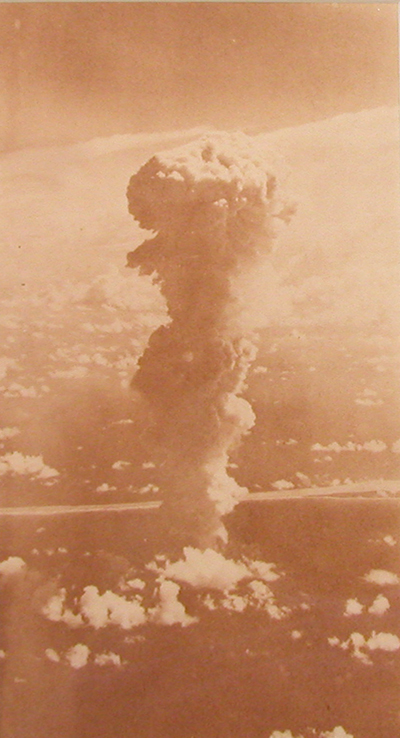Uranotype of Atomic Test Able

Shot Able took place June 30, 1946 at Bikini in the Pacific. It was the first of the two atomic tests that constituted Operation Crossroads. The detonation occurred just above the surface of the lagoon, and the yield was nominal, ca. 21 kilotons.
This print of Shot Able, produced in 2004 by Blake Ferris, is a uranotype (approximately 4" x 8").
During the infancy of photography in the mid 1800s, a variety of light sensitive metallic salts were investigated for use in producing photographic images. While the silver halides would ultimately prove to be the best, salts of platinum and uranium were, for a time at least, widely employed.
The first use of uranium in photography is credited to J. Charles Burnett who in the 1850s employed uranyl nitrate as the photosensitive salt.
The process for producing a uranotype is more or less as follows:
- First, the paper is sensitized by soaking it in a solution of uranyl nitrate and allowing it to dry.
- Next, the negative (high contrast) is placed in contact with the paper and exposed to ultraviolet light.
- Finally, the exposed print is developed in a ferrocyanide solution and washed. The resulting reddish image is due to the formation of uranyl ferrocyanide.
Note that the image in a uranotype is produced by uranium. This is different from the situation wherein uranium is used as a toner to alter the image created by another metallic salt (e.g., silver bromide).
The surface activity of the accompanying photo is approximately 900 cpm above background as measured with a pancake GM probe. A radioactive plume.
The following are examples of the various formulae for the sensitizer and developer used to produce uranotypes.
- Sensitizer - 4 grams of uranium nitrate in 16 mls of water
- Developer - 10 grams of potassium ferricyanide in 300 mls of water
Photo donated by Blake Ferris.
